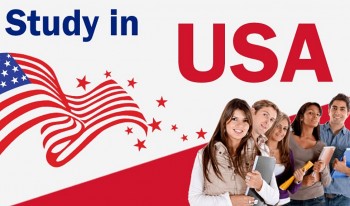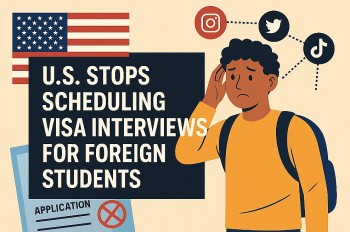How H‑1B Visa Changes Impact International Students in 2025/2026
 What Is the F-1 Visa That the U.S. Has Revoked for International Students? What Is the F-1 Visa That the U.S. Has Revoked for International Students? |
 UK Launches £10 Travel Authorisation Fee for Visitors as ETA System Expands to Europe UK Launches £10 Travel Authorisation Fee for Visitors as ETA System Expands to Europe |
For decades, international students have seen the United States not just as a place to study, but as a launchpad for global careers. A U.S. degree, combined with work authorization through programs like Optional Practical Training (OPT) and the H‑1B visa, opened a clear path from classroom to career.
But in 2025, that path just became much narrower.
With the U.S. government imposing a $100,000 annual fee on every H‑1B visa petition, the economic and strategic calculus for employers has changed overnight. And international students—particularly those seeking to remain in the U.S. after graduation—are facing new and urgent challenges.
Read more: H‑1B Visa $100,000 Fee: What It Means, Who’s Affected, and Why It Matters
 |
| How H‑1B visa changes affect international students |
Why the H‑1B Visa Still Matters
For most international students on F‑1 visas, the H‑1B remains the primary route to stay and work in the United States after completing their degree. Here’s how it typically works:
-
Students complete their degree program.
-
They apply for OPT (Optional Practical Training), gaining 12 to 36 months of work authorization.
-
During OPT, they find an employer willing to sponsor them for an H‑1B visa.
-
If selected in the annual H‑1B lottery and approved, they transition to long-term employment.
That model worked—until now.
What Changed in 2025?
In September 2025, the U.S. administration announced a new rule: any company submitting an H‑1B petition must now pay a $100,000 non-refundable annual fee per employee. This is on top of existing legal and filing fees, which already range from $5,000 to $10,000 per case.
The stated purpose of the policy is to:
-
Curb abuse of the H‑1B system by companies hiring foreign workers at low wages.
-
Push employers to sponsor only highly compensated, highly skilled professionals.
-
Encourage companies to hire American workers first.
But the consequences go far beyond those goals.
How International Students Are Affected
1. A Sharp Decline in Entry-Level Job Offers
With the massive increase in sponsorship costs, many companies—especially small businesses and startups—are pulling back from sponsoring new graduates. Entry-level roles are often the first to be cut from visa sponsorship plans. That leaves many international students with fewer job options after graduation, even if they hold degrees in high-demand fields like computer science or engineering.
2. OPT Becomes a Dead-End Without H‑1B
STEM students still benefit from a 24-month OPT extension, giving them extra time to gain U.S. work experience. But without a realistic shot at H‑1B sponsorship, OPT is no longer a bridge to long-term employment—it’s a time-limited opportunity that now leads nowhere.
3. Higher Bar for Sponsorship
Companies that still pursue H‑1B petitions will do so for roles where the return on investment justifies the cost—typically high-salary, senior-level positions. That means international students now face intense competition not just for jobs, but for sponsorship-worthy jobs. Employers will demand more experience, deeper skill sets, and a stronger value proposition.
4. Shift in Global Student Preferences
One of the biggest long-term consequences may be a shift in where international students choose to study. Countries like Canada, the UK, Australia, and Germany are already offering friendlier post-graduation visa policies. If staying in the U.S. becomes too difficult or unpredictable, many students may take their talents elsewhere—hurting U.S. universities and innovation in the process.
Read more: How H‑1B Visa Changes Impact Workers in 2025/2026
What This Means for U.S. Universities
International students are a vital part of the U.S. higher education system. They contribute not only tuition dollars, but also research, entrepreneurship, and cultural diversity. Fields like data science, engineering, and mathematics rely heavily on international graduate students to fill classrooms and lab positions.
If the pathway from education to employment is cut off or made uncertain, U.S. universities may face:
-
Declining enrollment from global talent.
-
Loss of top research candidates.
-
Reduced competitiveness compared to international institutions.
The cost of this policy could be measured not only in dollars, but in the global standing of American higher education.
Strategic Moves for International Students
Despite the challenges, all is not lost. International students can still pursue meaningful career paths—if they plan carefully and act early.
Start Planning in Year One
Don’t wait until graduation. Understand your visa options from the start of your program. Work with your university’s international student office and stay informed on policy updates.
Focus on In-Demand Skills
Prioritize skills that employers value most—especially in areas like artificial intelligence, cybersecurity, machine learning, biotech, and cloud infrastructure. The more specialized your skills, the higher your chances of being sponsored despite the fee.
Explore Alternative Visa Options
The H‑1B isn’t the only route. Depending on your profile, you might qualify for:
-
The O‑1 visa for individuals with extraordinary ability.
-
The L‑1 visa if you work for a multinational company and are transferred to the U.S.
-
The TN visa if you’re a Canadian or Mexican citizen.
-
Employer-sponsored green cards (EB‑2 or EB‑3), which offer more stability long term.
Be Open to Global Opportunities
Sometimes the smartest move is to launch your career outside the U.S.—at least for now. Many students are building careers in Canada, the UK, or Europe, with the option to return to the U.S. later under more favorable conditions.
Final Thoughts
The $100,000 H‑1B visa fee represents more than a policy change. It’s a turning point in how the U.S. attracts and retains global talent.
For international students, this shift demands a new mindset: proactive, strategic, and globally aware. The opportunities still exist—but the game has changed. Success now belongs to those who plan ahead, build rare skills, and stay flexible in an increasingly competitive global labor market.
Frequently Asked Questions (FAQs)
1. Can international students still apply for H‑1B after graduation?
Yes, but the employer must be willing to pay the $100,000 annual fee. This is significantly reducing the number of companies offering sponsorship, especially for entry-level roles.
2. Does this policy affect all international students?
Indirectly, yes. While the fee is aimed at employers, it limits job opportunities for recent graduates and increases competition for H‑1B slots.
3. Is STEM OPT still available?
Yes. Students in approved STEM fields can still apply for the 24-month extension. However, without viable H‑1B sponsorship, it’s a temporary solution.
4. What are alternatives to H‑1B for staying in the U.S.?
Depending on your background, you might explore the O‑1, L‑1, or TN visa routes—or pursue employer-sponsored green cards.
5. Will this affect my decision to study in the U.S.?
It might. Many students are now comparing post-graduation visa options across countries before choosing where to study.
6. Can I work for a U.S. company remotely from my home country?
Yes, remote work is a growing option. But it does not provide a U.S. visa or lead to permanent residency.
 What Are the New U.S. Visa Interview Rules in 2025? Don’t Miss These Visa Changes What Are the New U.S. Visa Interview Rules in 2025? Don’t Miss These Visa Changes Planning a trip to the United States after April 2025? You’ll want to pay close attention. |
 Fact Check: New U.S. Policy on Terminating International Students’ Legal Status Fact Check: New U.S. Policy on Terminating International Students’ Legal Status In early 2025, a U.S. government policy targeting thousands of international students shocked the higher education community. |
 U.S. Halts Student Visa Interviews: What This Means and How to Prepare U.S. Halts Student Visa Interviews: What This Means and How to Prepare The U.S. has suspended new student visa interviews to expand social media vetting. This update affects thousands of international applicants. Learn what it means, who’s ... |
 How Many Chinese Students Are in the U.S.? Latest Numbers, Visa Crackdowns, and What’s Next How Many Chinese Students Are in the U.S.? Latest Numbers, Visa Crackdowns, and What’s Next Chinese students have long been a significant presence in American universities, contributing to academic excellence and cultural diversity. |























